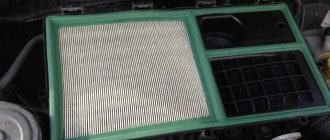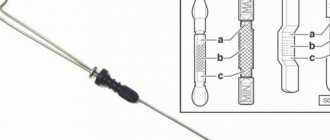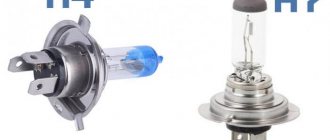One of the main elements of the Volkswagen Polo gasoline engine control system is the ignition coil. If a part fails, ignition does not occur in the cylinders.
The coil converts electrical impulses with an amplitude of 12 volts into high-voltage impulses (15 thousand volts). Such a high voltage ensures breakdown of the working area of the spark plug.
Symptoms of a problem
When the ignition coil fails, misfires appear in the cylinder for which this particular ignition coil is responsible. It happens that the coil does not fail immediately, but gradually, its insulation breaks through and the spark begins to leak onto the housing under heavy loads.
If the IKZ does not work correctly on the car, the following symptoms of a malfunction appear:
- The “CheckEngine” light starts flashing;
- The traction and dynamics of the car disappear;
- The car starts to move jerkily;
- Popping sounds are heard from the exhaust pipe;
- The exhaust at idle is not uniform;
It should be noted that such symptoms can be associated not only with ICD, but also with injectors, compression, spark plugs, etc. To be sure that the IKZ is faulty, it must be checked.
How many spark plugs are there in a Volkswagen Polo?
On the Volkswagen Polo Sedan 1.6, depending on the engine installed on it (CFNA, CFNB, CWVA, CWVB), two different spark plugs are installed. In CWVA and CWVB engines with VAG part number 04C905616. They are nickel, have one side electrode, and are screwed in with a tightening torque of 23 Nm.
Setting the ignition of a VW Passat B3 with an ABS engine using the VAG-COM program and a strobe light
The ignition of a VW Passat B3 with an ABS engine is set as follows.
- Warm up the car and turn off the engine.
- Open the timing cover. The mark on the plastic cover should match the groove on the pulley. Otherwise, remove the car from the handbrake, set second gear and push the car (the pulley will rotate) until the marks match. The mark on the timing cover must coincide with the groove on the pulley
- Open the distributor cover - the slider should be turned towards the first cylinder. The distributor slider should be turned towards the first cylinder
- Open the inspection window plug and see if the marks match. The coincidence of the marks is checked through the inspection window
- Connect the strobe wire and battery power to the first cylinder. Unscrew the nut under the distributor. The strobe cord is connected through the diagnostic connectors
- Press the key on the strobe gun and bring it to the viewing window. The mark should be opposite the top tab. If this is not the case, twist the distributor. When installing the ignition, the strobe light is brought to the viewing window
- Connect the adapter.
- Launch the VAG-COM program. Remove the car from second gear and start the engine. To adjust the ignition, the VAG-COM program is used
- In the VAG-COM program, go to the “Engine Block” section. After starting the VAG-COM program, you need to go to the “Engine Block” section
- Select the “Measurement Mode” tab and click the “Basic Settings” button on the left. Using the VAG-COM program you can quickly and accurately set the ignition
- Tighten the distributor bolt.
- In the VAG-COM program, return to the “Measurement Mode” tab.
- Disconnect the strobe and diagnostic cords.
- Close the inspection window plug.
Spark plug diagnostics
Faulty spark plugs can be determined visually by the following signs:
- deposits on the spark plug;
- melted electrodes;
- a layer of soot on the tip of the spark plug;
- traces of oil on the tip of the spark plug.
You can diagnose a faulty spark plug using a number of external signs.
There are several reasons why spark plugs fail:
- wear and exceeding the service life;
- frequent regular driving over short distances;
- high engine oil level;
- unbalanced air-fuel mixture.
In what cases is it necessary to replace spark plugs?
A high voltage is applied to the SZ, due to which a spark appears between the electrodes, igniting the combustible mixture. The quality of spark plugs affects the efficiency of the internal combustion engine and fuel economy. Therefore, it is necessary to monitor their condition.
Replacing the SZ on any car is done for two reasons:
- according to the technical maintenance regulations;
- in case of wear or malfunction of the SZ, which causes incorrect operation of the engine.
According to the regulations on Volkswagen Polo cars, replacement of the SZ must be carried out after 30 thousand kilometers.
But you need to change the spark plugs when the following signs appear:
- the car jerks while driving;
- the starter does not fire immediately; several idle revolutions are required to start the engine;
- increased fuel consumption;
- Motor power drops.
In addition, it is recommended to perform a technical inspection of the car after 15 thousand kilometers. During inspection, the condition of the SZ should be checked. Spark plugs require replacement if a visual inspection reveals cracks in the body or peeling of the insulator. It is better to change the entire set of SZ.
Press the two spark plug cap latches.
How to fix a locked lock?
Quite often the problem of blocking the ignition switch arises. This usually occurs due to the use of an anti-theft system integrated into the steering column.
It works as follows: if there is no key in the lock, then it is impossible to turn the steering wheel.
To unlock the steering wheel, you need to insert the key into the lock and try to find a position in which the key can be turned.
If the lock cylinder is not blocked by a spring, then local repair of the lock well is possible. In case of blocking, a new lock is needed - jewelry repair of the spring will cost much more.
Selection of spark plugs for Volkswagen cars
There are a number of important things to consider when purchasing new spark plugs. Candles differ in design and material from which they are made. Spark plugs can be:
- two-electrode (with one side and one central electrode);
- multi-electrode (with one central and several side electrodes).
Multi-electrode spark plugs have multiple side electrodes
For the manufacture of electrodes the following are used:
- yttrium and copper (available, but not very resistant to fading);
- platinum (very reliable, corrosion resistant, but expensive).
When choosing candles, you need to pay attention to the heat rating. Failure to meet the manufacturer's requirements will result in a number of problems. If it is greater than the regulated values, the load on the engine will increase and lead to its forced operation. If the heat rating is low, problems will arise when starting the engine due to an insufficiently powerful spark.
It is advisable to purchase original Volkswagen spark plugs, which:
- have high wear resistance;
- ignite the mixture efficiently;
- function reliably throughout the entire service life.
The highest quality spark plugs are produced by Bosch, Denso, Champion, NGK. Their price varies from 100 to 1000 rubles.
Step-by-step analysis of the lock and repair
- Clear access to the steering column should be ensured;
- Unscrew the two screws on the plastic steering column housing;
- We disconnect the steering cardan using a key set to “13” - unscrew the nut and remove the restraining spring;
- Carefully release the latches and disconnect the circuit boards from the steering wheel column;
- Remove the column casing using a hexagon size “6”;
- We take out the shaft with the switches.
Now you need to understand what to do: does it make sense to repair the core or a complete replacement with a new one would be a rational option.
You can repair the lock by replacing contact groups 357905865, 6N0905865 with new ones, which, of course, is much cheaper than buying a new ignition switch.
Basic knowledge of ignition systems
One of the main conditions for starting the engine is a properly functioning ignition system. This system delivers an electrical discharge at a certain moment when the engine is started, after which the gasoline engine starts.
Typically, the ignition system includes:
- Distributor;
- Coils;
- Candles;
- Control block.
Sometimes a machine can be equipped with a transistor-type non-contact starting system, consisting of a similar list of components as a conventional system, but its fuel distribution system does not have a Hall detector and an air-fuel mixture condenser. Instead, an ignition system of this type uses a special non-contact type sensor, the functionality of which, however, is based on the same physical principles.
Diesel engines differ slightly in their starting system: ignition in this case should be called fuel injection during the compression stroke, with a mixture of diesel fuel and air being injected into the engine separately. Initially, air is supplied to the system, which is very hot in the combustion chamber. After this, the chamber is filled with a fuel mixture through nozzles and immediately ignites.
Sources:
https://motyk.ru/info/kak-proverit-katushku-zazhiganija-shevrole/ https://555-shop.ru/zapchasti/kak-snyat-katushku-Polo-sedan.html https://Nissan-modus .ru/prochee/katushka-zazhiganiya-na-folksvagen-Polo-sedan-zamena.html
Checking the ignition coil Polo Sedan
In order to start checking the ignition coil on the Polo Sedan, you need to determine which cylinder is not working. This can be done in two ways: using hearing and using a diagnostic device. Let's consider both options and start with the more accessible and simpler one - hearing.
Determining a faulty coil using hearing
It is necessary to start the car and alternately remove and put on the connectors from the IKZ. If you remove the connector from the ignition coil of a good cylinder, the operation of the engine will change, the speed will drop and detonation will appear, but if you remove the connector from the faulty cylinder, the operation of the engine will not change. As soon as you find a cylinder on which, when the connector is removed from the IKZ, the idle speed will not drop, this will mean that this cylinder is not working.
Determining a faulty coil using the device
You can determine if the coil of any of the cylinders is broken using a diagnostic tool. Diagnostics at a service station are quite expensive, so an alternative to such diagnostics is the Chinese ELM327 scanner, which can easily determine which cylinder is leaking. You just need to connect your smartphone to the scanner and read the ECU for errors.
Once the non-working cylinder has been found, you can begin checking the coil itself.
IKZ check
The test is carried out in two ways: checking with a multimeter and substitution. The second method is the simplest, but requires a known working IKZ nearby; the first option is less accurate, but at the same time less expensive. Let's consider each of the options in more detail.
Checking with a multimeter
To carry out this check, it is necessary to remove the suspicious ICP from the car engine.
- On the multimeter, set the switch to the resistance measurement parameter;
- Connect the multimeter probes to the low side of the coil (primary winding); the resistance of this winding should be in the range of 0.5 - 1.5 Ohms;
- Next, we connect the probes to the secondary winding (high side), the resistance of this winding should be in the range of 2.5 - 4 kOhm;
- If the readings do not correspond to the nominal values, then most likely the ignition coil is faulty and requires replacement;
It happens that even if the nominal values coincide, the coil still does not work; this may happen through the vein of insulating rubber bands that have cracks.
A little about the design
It is absolutely appropriate to note that in fact it may not be individual.
An example of this is Opel’s Z16XER engine, where an ignition module is assembled from such parts, which, by the way, causes even more headaches than stand-alone versions for each cylinder. But that’s not about that now. The design of an individual ignition coil includes the following elements:
- Contact output.
- The primary, secondary windings and high voltage core are enclosed in a single housing.
- A spring.
- An insulating tip that fits onto the spark plug.
Replacing the ignition coil
Replacement is quite simple and will not be difficult even for a person who has no experience in car repairs. It should be noted that without a special puller, making a replacement will be quite problematic.
Puller IKZ Polo Sedan
- Remove the decorative trim of the engine;
- Remove the connector from the ignition coil;
- Using a puller, remove the coil;
- We install a new coil and put on the connector;
- The replacement process is complete;
Possible problems of poor engine starting
If the starter does not activate at all and the traction relay does not operate, then two types of malfunction are likely: in fact, the starter itself has “died” or there is a violation in the electronic circuit. A rare occurrence is a fuse installed on the power circuit. Fortunately, Volkswagen Polo does not own such a device, so we exclude the possibility of a fuse failure.
The reason for the lack of power is a dead battery or poorly tightened wires at the terminals. With the wires, everything is very simple: we tighten them, and the power is restored. If the battery is at “zero”, then we cannot do without outside help: we are looking for a good Samaritan who will give us a “light”.
Sluggish starter operation is also not good. This is a sign of a weak battery charge. Therefore, we either charge the battery or replace it with a fresh one.
The vigorous operation of the starter eliminates the preconditions associated with the battery. The depressed motorist faces two other difficulties. The first is located in a plane called the ignition system. The second lies in the fuel supply system.
In most cases, there is one problem. The engine will not start because there is no spark. There is only one question: in what specific part of the system did the problem occur?
The low-voltage part consists of a sensor and a special box stuffed with electronics. The desired spark appears in it. The second component is a transformer, or in common parlance, coil to which the spark plugs are connected. Thanks to distributors, high-voltage wires feed the spark plugs with high voltage current. The final step is the spark plugs, which provide the spark needed to start the engine.
The check must be carried out in a special manner. We start with the high-voltage part: remove the wire from the distributor and fasten its end next to the car body. We make sure that the wire does not touch the surface, otherwise all the electronics on the car will fail. We start the engine and look at the tip of the wire. A charge of electricity should jump between it and the body. If this does not happen, remove the cover from the distributor, clean its contacts, and inspect the “slider” and wires. If there are any flaws, we replace the parts. You also need to dry candles filled with gasoline.
The serviceability of the spark plugs is a new step of verification. We take them out of the coil, connect high-voltage wires to them, collect them into a bundle and start the starter. Small sparks flash on the electrodes of the spark plugs. If there is still no spark, then it means the problem is deeper than expected.
In the next step, we check the coil, or more precisely, the voltage supplied to the element. This can be done using a tester or an engine compartment lamp. If there is no voltage, then the problem with the engine not starting is the coil. The defective part must be replaced. But it may be that the current is not flowing as a result of a disgusting connection of wires or obvious contamination.
The last limit is the low voltage part of the system. The only thing that can be done here is to “poke” the contacts of the distributor connector. Voltage leakage may be due to them. But if there is still no voltage, then it means you should take the car for computer diagnostics of electrical systems. Using special equipment, technicians will identify the cause of the malfunction.
The most unique reason why the engine does not start is a breakdown of the camshaft drive belt. Basically, it is associated with the worn-out serrated surface of the tape. It is better to entrust the repair of the mechanism to experts.
Ignition coil tip for Volkswagen Polo
Quite often, owners of the Polo Sedan are faced with the cause of cracking and the appearance of microcracks at the tip of the ignition coil, which insulates the spark plug and prevents sparks from breaking through to the body. Due to the constant high temperature inside the cylinder head well, the rubber part loses its properties and dries out, which leads to the appearance of cracks through which a high voltage spark breaks through to the body, not reaching the spark plug and, accordingly, the combustion chamber. This is why the engine misfires.
In case of such a breakdown, you should not rush to change the ignition coil; you just need to buy an ignition coil repair kit for the Volkswagen Polo Sedan and replace it, after which the ignition coil will work like new.











